
“It is a discipline in the equality of man. For all men are equal before fish.” ~Herbert Hoover
Spring trout season opens up around here in less than a month, and I’m sure that’s the case for pretty much every other state in the country, too.
I’d have liked to do a little more planning on this but you need to strike while the iron is hot, and all, so I wanted also to get a leg up on some spring trout fishing tips.
Now, to be clear, where I live in the country the trout I fish for (in my part of the state, at least) are all stockies.
Stockies are not only dumber but less wary than wild fish, but you know what? When you’re fishing for the frying pan (and I am) that’s a bonus, not a drawback.
It’s less of a challenge to catch stockies but fish you caught always tastes better than fish you bought, so here are some of my top tips.
Spinners (Bonus Points If You Made Them Yourself)

If I had to liquidate my entire collection of tackle boxes and bags and keep only one type of lure for trout fishing, I can confidently say, without the least shadow of a doubt, that I’d cling to my inline spinners.
The number of trout I’ve caught on inline spinners dwarfs the number of fish I’ve caught on other lures, combined. And really, it’s not even close.
I don’t know what it is about metals (specifically spinners) but trout love them. Maybe it’s the noise, maybe it’s the flash, but I’ll tell you this much. If you fish spinners, you’re going to catch trout.
There are a ton of different types of spinners that I like to fish for trout. Smaller spinners perform best, in my opinion, not to mention the fact that smaller, lighter spinners, despite the fact that they are hard to cast, can be run shallow, which is a big bonus in these shallow streams where trout live (and are stocked).
Some of the best spinners I have used for trout are Rooster Tails, Mepps Aglia, Panther Martins, and Rooster Tail Vibrax spinners, which are basically the same pattern as Panther Martins. Other good spinners include Blue Fox Flash, Blue Fox Whip Tails, and South Bend inline spinners.
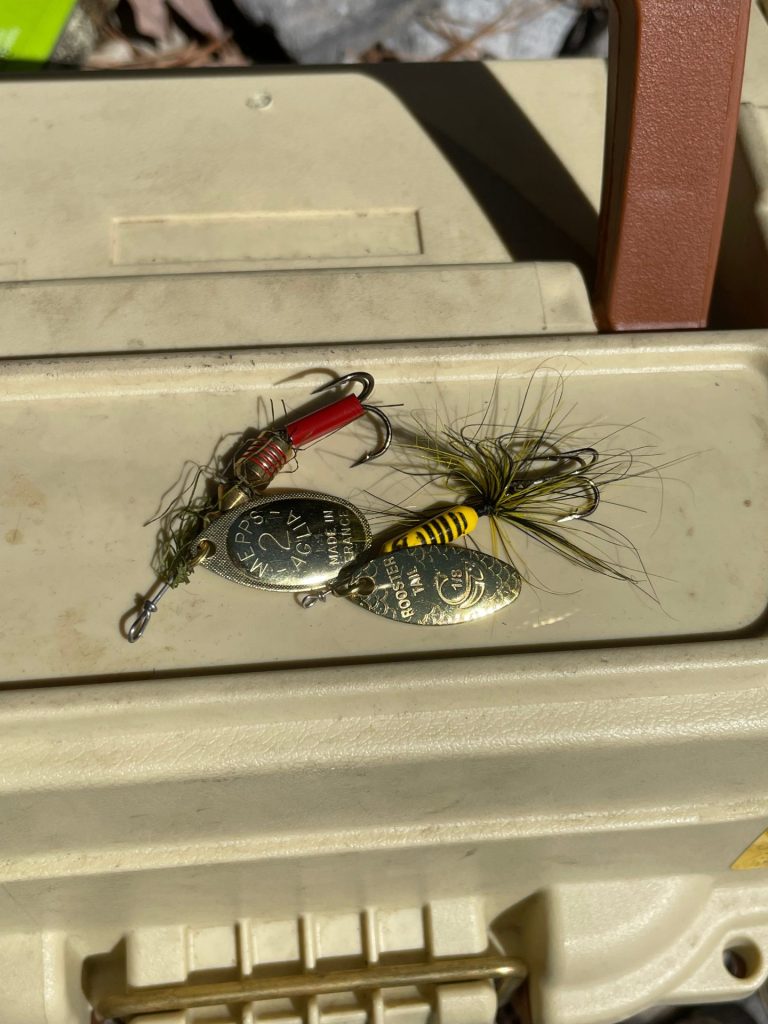
My favorites are Mepps Aglia and Rooster Tail spinners. Size 0-2 on the Mepps, and ⅛ oz on the Rooster Tail, both with a gold blade.
But, if I had to pick one specific spinner to fish for trout, I’d pick the spinners I made myself. I suggest you learn how to make them too.
Why fish spinners you made yourself instead of spinners you bought? Well, there are several good reasons that I plumb in full depth in that blog. The two best reasons are that they’re new which guarantees fish won’t have seen them before (which is not too much of a concern because stockies are naive) and they’re more affordable. Fish as much as I do, and you’ll probably lose lures on snags with a greater frequency than you hook fish. Not that I’m proud to admit that but it’s also true.

Anyway, those are the reasons to make your own spinners.
But whether you make your own spinners or buy them, here are the most effective ways that I’ve learned to fish them.
The most effective way I’ve learned to fish spinners for trout is to cast them far upstream and retrieve the cast downstream back to you. This brings the lure in line with the current and gives it the impression of a small piece of bait that’s taken by the current. I’ve read that this is most realistic, because only strong targets fight the current. Not sure what the science is behind it but my experience says that baits fished down-current more strikes than those fished up current.
Another great way to fish inline spinners for trout is to cast across the current, but slightly upcurrent. Swing the spinner across the stream or creek or river as the current brings it downstream. This brings the lure in line with the current and allows you to search the entire creek bed, covering both shallow and deep water.
Another very effective technique with spinners is to cast the spinner over holes and then burn it back. More often than not, the strike will come sooner rather than later.
You can also cast into and in front of cover, such as submerged stumps, downed trees, and log/stick jams. I find that trout generally hide out in the eddies behind them, but sometimes they hang out around in the front too.
You know, structure is good. Throw your spinner at them and you may very well flush them out, whether you’re in the front or the back.
You can also just cast your lure downstream and burn it back. Just be aware that the resistance of the current is going to cause the spinner to rise through the column of the water and it’s very difficult to fish a spinner deep when bringing it upstream.
As for speed, the best way I’ve found to fish spinners for trout is to fish it just fast enough that the blade spins. As slow as possible while still keeping the blade turning.
All in all, this is the single best piece of advice I can offer when it comes to fishing spinners for spring trout, stockie or not.
Spoons (and How to Fish Them for Trout)
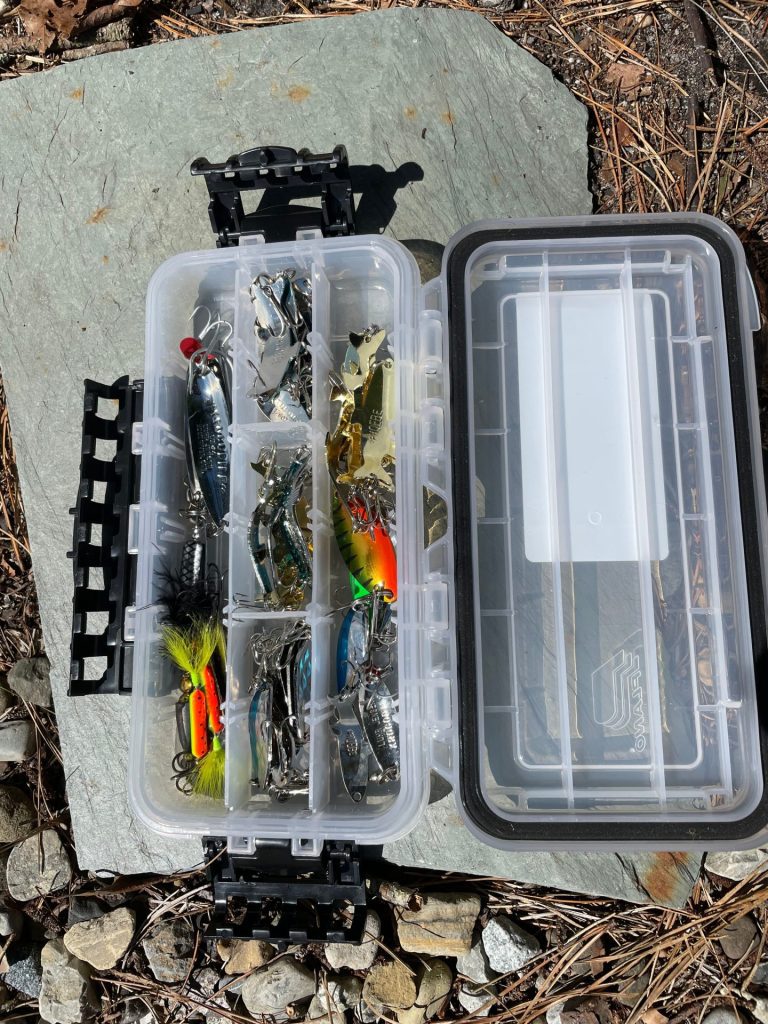
I’ve thus far divulged that if I had to give up all other lures and just chase trout with one category, I’d keep my spinners.
But if for some reason I could not fish spinners, I know what my number two would be, and it’s spoons.
The reason I prefer spinners is that trout seem to prefer them. It’s as easy as that. The truth about spinners is that you can cover a lot more water a lot more efficiently. They’re searching lures, and they just happen to be highly effective on trout.
But the truth is also that, despite the fact that it seems to me like trout like spinners better, spoons are far, far more versatile lures.
There are a number of advantages that spoons have over spinners.
They are denser, so they can be cast much farther and with greater accuracy.
They are more durable. If you catch a few fish on a spinner, often you need to straighten out the body. Sometimes fish bend the clevis and take the spinner out of commission until you can make repairs.
There is nothing you can do to a spoon (or that a fish can do, for that matter) to take it out of commission. There are no moving parts and nothing to tune. It’s a chunk of metal. It’s not going to quit.
Spoons are also quieter than spinners, but when fished aggressively they can also be used to make a great deal of noise in the water, and moreover, they have the same flash factor.
Spinners will foul if not fished at the right speed. Undue changes in the current can also
cause the blade to stop turning. This will not happen with a spoon.
Also, spoons can be fished fast or slow, shallow or deep. With a spoon, you can pull a straight retrieve, a stop and go, a yo-yo cadence. You can jig a spoon, you can also cast a spoon and give it a fast twitch back to the shore. Few of these techniques are viable with spinners.
So, all in all, spoons have a lot of the virtues of spinners and they are much more versatile.
What do I prefer? There are tons of spoons that are effective on spring trout. My favorite is probably a small silver or silver and blue Acme Kastmaster, either ⅛ or a ¼ ounce. Gold is good too.
This pattern is a bit expensive, though. South Bend makes excellent spoons that are patterned after the Kastmaster at a fraction of the price.
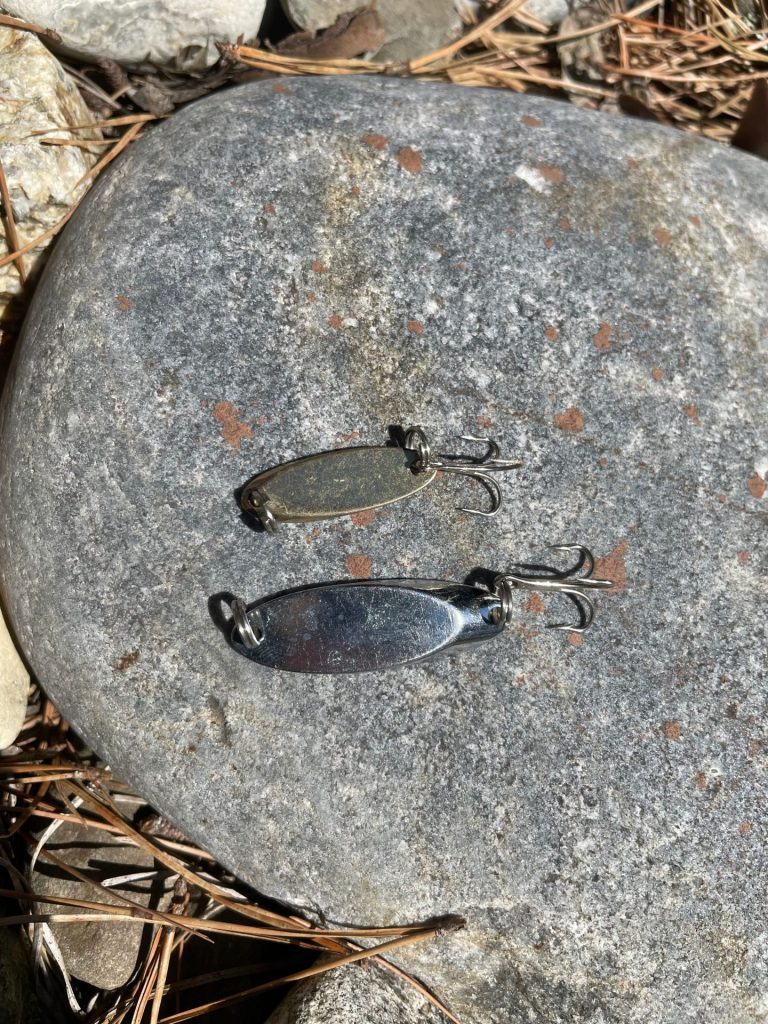
Johnson Silver Minnows are good, too, as are Acme Little Cleos and Acme Phoebes. Trout are not brand loyal, though, so don’t but on brand. Buy on pattern.
As for technique, there are a lot of things you can do with a spoon.
My favorite technique with a spoon is very similar to my favorite technique with a spinner. Cast your spoon upstream and fish it downstream back to you. My favorite cadence is a slow twitch that gives the spoon a wide wobble or a darting movement. Second is a slow, steady retrieve that produces a wide wobble.
You can also create a yo-yo cadence by raising the rod tip and allowing the spoon to flutter on the drop. This is effective on trout, too. Be ready for the strike on the drop, that’s usually when it comes.
Casting and twitching the spoon back to you is also highly effective. Don’t be too quick about it or the spoon may foul.
Just like a spinner, you can also cast a spoon across the current and swing it back to you. Slow, steady retrieves and twitching are highly effective. The slower the better, although you can experiment with a faster retrieve if the fish are finicky. I don’t find faster techniques to be the best approach, generally, but sometimes they perform well.
Another great way to get trout to take a spoon is to drop it right on their nose. If you see a hole, throw your spoon right into it and let it drop. When you crank the slack out of your line, be prepared for there to be a trout on the end of it.
The other thing you can do is cast to structure. If you see submerged logs, sticks, clumps of weeds, rocks, pilings, and other similar obstructions, cast to them, let your spoon drop, then start working it back to you. Trout will usually jump at the chance to swipe an easy meal.
If these techniques detailed above are not performing, try casting downstream and bringing the spoon upstream back to you. That is not a technique I will try a lot, but sometimes it produces.
Soft Baits (Not My Go-to, Though)
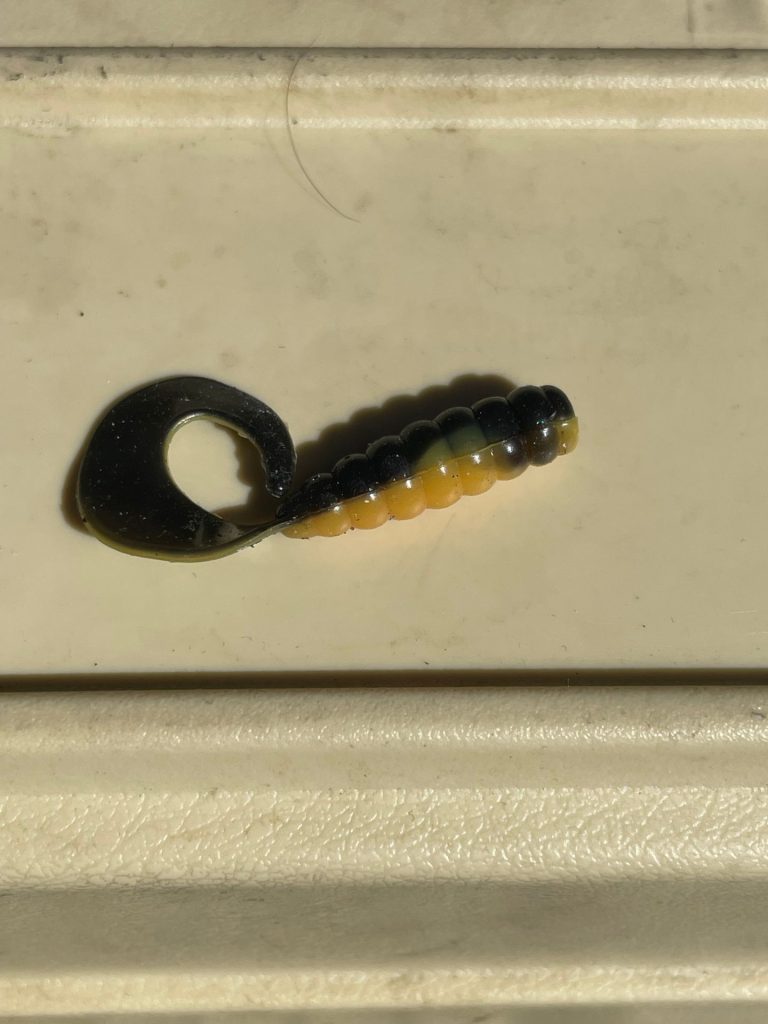
I would be a very happy person if all I had in my trout box for the rest of my life were spinners and spoons. But if I had to stock a third, it would be a soft bait – and a very specific one, at that.
That would be a curly tail grub rigged on a jighead. Preferably, a 1/16 or ⅛ ounce jighead. I am ambivalent about color. I’ve caught trout on curly tail grubs of many colors.
I find this sort of interesting because a fellow trout fisherman once swore up and down that I would never catch trout on soft baits, even though I had just done so before engaging him.
Among fishermen, superstition dies hard. To be fair, if I lacked this specific experience, I’d hold his convictions.
Others have told me that plugs, like Rapala Original Floaters and Yo-Zuri Minnows, are more effective for trout. They very well may be, but they’ve never really produced for me.
If they work for you, keep using them, and let me know what techniques work best in the comments. Till then, I will keep using my curly tail grubs.
Anyway, rigging is straightforward. Rig the grub on the jighead with the hook exposed. After that, the world is your oyster. There is no wrong way to fish these lures.
One of the best ways to fish them is to catch to structure, eddies, or pockets of deep water. Let the grub sink till it hits the bottom, then hop it along the bottom back to you. This performs well for trout particularly in shallow water.
You can also cast the grub upstream, just like a spinner, and then give it a stop-and-go retrieve or a yo-yo retrieve back to you. These techniques are also effective on trout.
I find you can also cast a curly tail grub straight across the current and twitch it or hop it back across the stream to you. A lot of strikes will come about midway back to you, which also generally corresponds to deep water.
Pretty much the only thing I will not do with a curly tail grub rigged on a jighead is give it a straight retrieve back to me. Literally everything else is fair game.
The best advice I can give you is to be flexible with it and keep an open mind. If you stumble on a technique that I have not mentioned here, by all means, let me know what it is in the comments. I’d like to know myself, and I’ll amend this post with your wisdom.
Just a caveat, here. This is never my first option. Try fishing metals first, if you have them, and if the trout snub you, then tie on a curly tail grub with a jighead and see if that works better. It just might. No one technique produces all the time, even on naive stockies.
Also, a note. These are like the most effective lures of all time. Don’t be surprised if you get a lot of bycatch while you’re targeting trout like this. Everything else that swims will take a swim at these soft baits, too.
While trout fishing with soft baits, using some of the techniques listed above, I have caught bullheads, channel cats, white cats, snakeheads, crappies, perch, panfish, bass, pickerel, and probably some other species that I’m forgetting. So have at it.
Now Go Catch a Mess of Stockies
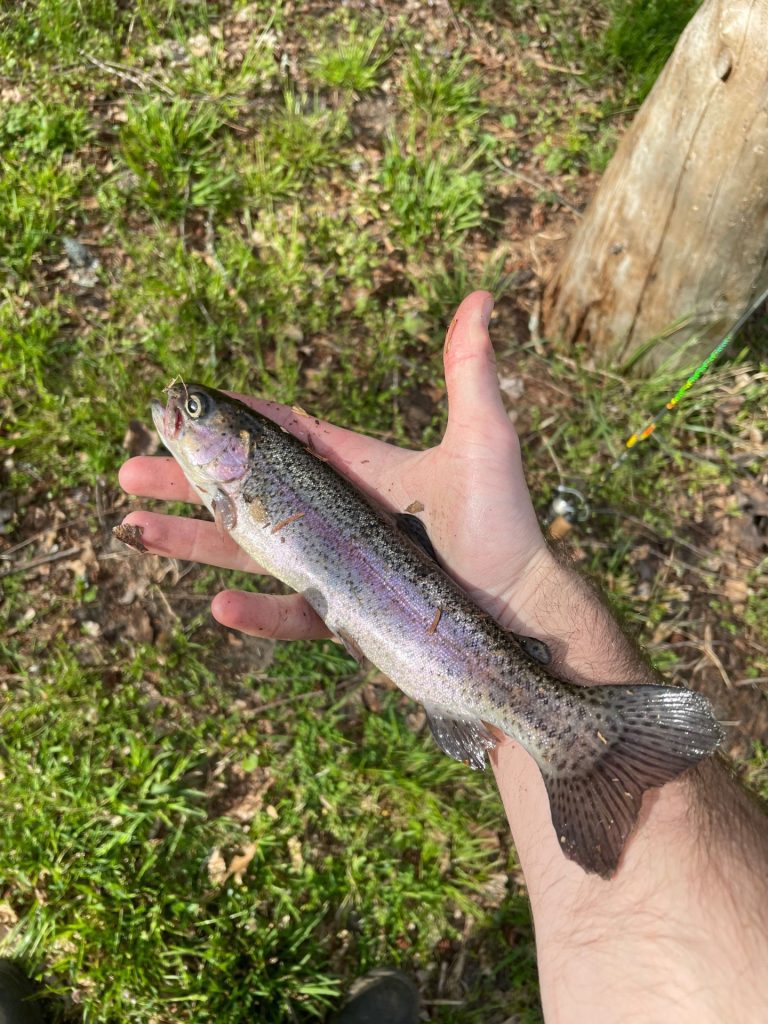
One of my favorite things about fishing for stockies is that, even though they aren’t wild, I don’t need to worry about depleting a native stock. This is fishing for food at its finest.
Try out some of these techniques this spring. I hope they work for you. They are some of the most straightforward techniques I know and they’ve been working for me for years.
Tight lines, and good luck.
~The Eclectic Outfitter